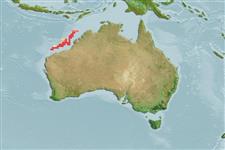>
Perciformes/Scorpaenoidei (Scorpionfishes) >
Neosebastidae (Gurnard scorpionfishes)
Etymology: Neosebastes: Greek, neos = new + Greek, sebastes = august, venerable (Ref. 45335); longirostris: Name after the Latin word 'longus' meaning long and 'rostrum' meaning snout, referring to the long snout..
Environment: milieu / climate zone / depth range / distribution range
Sinh thái học
Biển gần đáy; Mức độ sâu 170 - 250 m (Ref. 54394). Tropical; 14°S - 20°S (Ref. 54394)
Eastern Indian Ocean: Off northwestern coast of Western Australia.
Bộ gần gũi / Khối lượng (Trọng lượng) / Age
Maturity: Lm ? range ? - ? cm
Max length : 16.9 cm SL con đực/không giới tính; (Ref. 54394)
Short description
Hình thái học | Sinh trắc học
Các tia vây lưng cứng (tổng cộng): 8; Các vây lưng mềm (tổng cộng): 8; Tia cứng vây hậu môn 3; Tia mềm vây hậu môn: 5. Diagnosis: Underside of mandible with numerous tiny pores, no ridges. Preocular spine usually simple, and flattened anteriorly and posteriorly; supraocular spines occurring only posterior to vertical midline of eye; no additional spines between lacrimal and suborbital ridges; upper opercular spine simple. Midinterorbital space covered with scales; interorbital space shallow, becoming shallower with growth. Pored lateral-line scales 34-36 (mode 35); longitudinal scale rows 57-63 (57). Pectoral-fin rays 20-22 (21); pectoral fin short (2.9-3.5, mean 3.2 in SL), not reaching a vertical at origin of last dorsal-fin spine. Posterior margin of maxilla not reaching a vertical at posterior margin of pupil. Snout length long (3.5-4.0, 3.7 in HL); interorbital width wide (5.2-6.7, 5.7 in HL); body depth shallow (2.8-3.4, 3.1 in SL). Bilobed portion of swimbladder less than half of total swimbladder length. There are no distinct small black spots on head or lateral line (Ref. 54394).
Found on the continental shelf and continental slope (Ref. 75154). Most specimens taken in trawls have sand grains inside the mouth indicating occurrence on open, predominantly sandy substrata (Ref. 54394).
Life cycle and mating behavior
Chín muồi sinh dục | Sự tái sinh sản | Đẻ trứng | Các trứng | Sự sinh sản | Ấu trùng
Motomura, H., 2003. Revision of the scorpionfish genus Neosebastes (Scorpaeniformes: Neosebastidae), with descriptions of five new species. Indo-Pac. Fish. (37):46 p. (Ref. 54394)
IUCN Red List Status (Ref. 130435)
Threat to humans
Harmless
Human uses
Thêm thông tin
Age/SizeSự sinh trưởngLength-weightLength-lengthLength-frequenciesSinh trắc họcHình thái họcẤu trùngSự biến động ấu trùngBổ xungSự phong phúBRUVS
Các tài liệu tham khảoNuôi trồng thủy sảnTổng quan nuôi trồng thủy sảnCác giốngDi truyềnElectrophoresesDi sảnCác bệnhChế biếnNutrientsMass conversion
Các công cụ
Special reports
Download XML
Các nguồn internet
Estimates based on models
Preferred temperature (Ref.
123201): 13.6 - 19, mean 16.5 °C (based on 11 cells).
Phylogenetic diversity index (Ref.
82804): PD
50 = 0.5002 [Uniqueness, from 0.5 = low to 2.0 = high].
Bayesian length-weight: a=0.01995 (0.00906 - 0.04395), b=3.01 (2.83 - 3.19), in cm total length, based on all LWR estimates for this body shape (Ref.
93245).
Mức dinh dưỡng (Ref.
69278): 3.6 ±0.5 se; based on size and trophs of closest relatives
Fishing Vulnerability (Ref.
59153): Low vulnerability (11 of 100).
